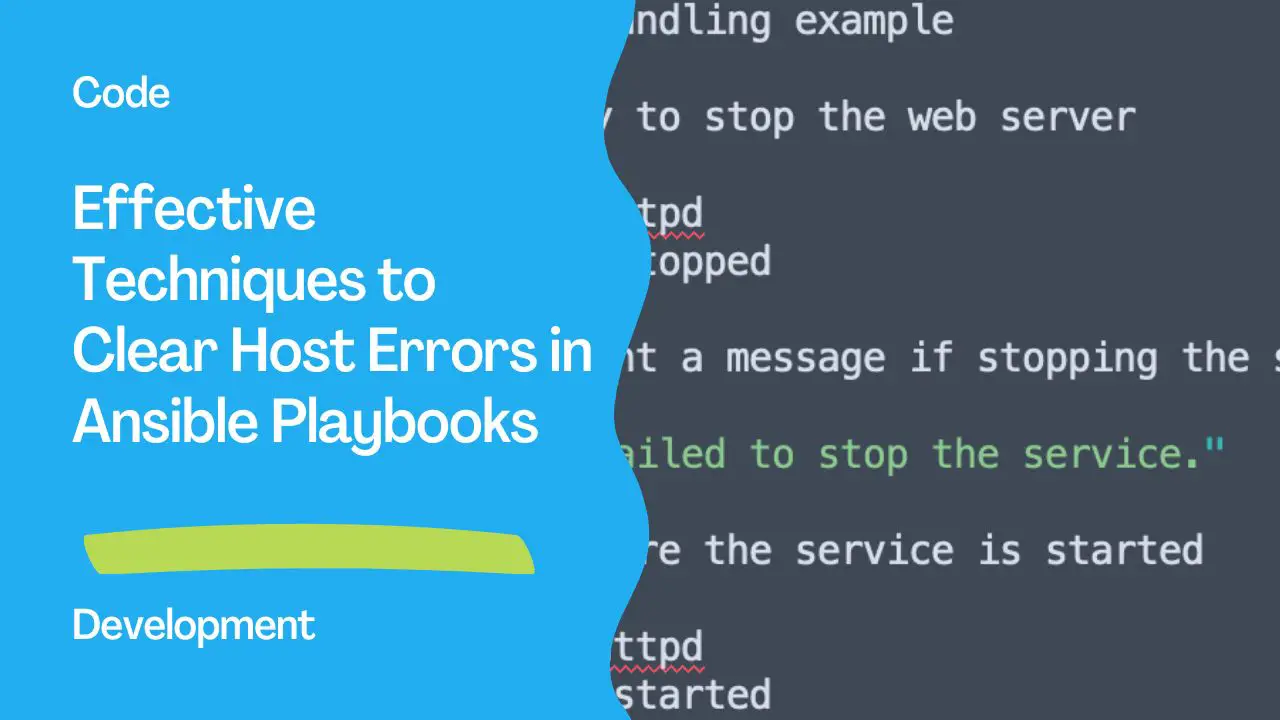Handling Host Errors in Ansible
In any automation system, handling errors efficiently is crucial to ensure smooth operations. Ansible, a popular IT automation tool, provides several mechanisms to manage errors during playbook execution. One common scenario is the need to clear or handle host errors to maintain an efficient and error-free automation environment. Below, we’ll explore the strategies to manage host errors effectively in Ansible, including retry mechanisms, failure conditions, and error handling practices.
Understanding Host Errors
Host errors in Ansible typically occur when there is an issue connecting to a host or executing a task on a host. These can include connection failures, unreachable hosts, task failures, or issues with privilege escalation. Ansible marks these hosts as “failed” and, by default, will not proceed with subsequent tasks for those hosts unless instructed otherwise.
Strategies to Clear Host Errors
Ignore Errors Using
ignore_errors: You can tell Ansible to ignore errors for specific tasks using theignore_errorsdirective. This is useful when you want the playbook to continue executing even if a particular task fails.- name: Attempt to stop a non-existent service service: name: non_existent_service state: stopped ignore_errors: yesHandle Failed Hosts with
rescueandalways: Ansible’sblock,rescue, andalwaysdirectives provide structured error handling.rescueruns if there is a failure within a block, andalwaysruns regardless of the block’s outcome.- name: Error handling example block: - name: Try to stop the web server service: name: httpd state: stopped rescue: - name: Print a message if stopping the service fails debug: msg: "Failed to stop the service." always: - name: Ensure the service is started service: name: httpd state: startedUse the
failed_whenConditional: Thefailed_whendirective allows you to specify custom failure conditions for tasks. This can be used to clear or handle host errors based on specific output or conditions.- name: Check for a specific file stat: path: /etc/some_file register: result - name: Fail if the file is not present debug: msg: "The file is present." failed_when: result.stat.exists == falseRetry Failed Hosts: Ansible allows retrying failed hosts with the
--limitand--retryoptions. You can rerun the playbook against the failed hosts captured in the*.retryfile.ansible-playbook site.yml --limit @/path/to/failed.retryConditional Handling with
when: You can use thewhendirective to conditionally execute tasks based on the state of the host or task outcomes. This can be combined with error conditions to handle host errors more gracefully.- name: Create a file only if previous command failed command: /bin/false register: command_result ignore_errors: yes - name: Touch a file file: path: /tmp/somefile state: touch when: command_result is failed
Clearing Host Errors
Clearing host errors effectively can mean resetting the state of the host in your inventory or ensuring that playbooks handle error conditions gracefully without manual intervention. For example:
Reset the Host State Manually: You may need to update your inventory or state-tracking files manually to reflect that a host is no longer in error.
Use the
meta: clear_host_errorsModule: Themetamodule in Ansible includes a special action calledclear_host_errorsthat can be used to reset the error state of a host during playbook execution.- meta: clear_host_errors
This clears the error status of a host so subsequent tasks will be executed on it, regardless of any previous failures.
Best Practices for Handling Host Errors
Log and Monitor Errors: Use logging and monitoring tools to capture and analyze errors. Implement alerting mechanisms for critical errors.
Graceful Degradation: Design your playbooks to degrade gracefully in the presence of errors. For example, allow non-critical tasks to fail without interrupting the entire workflow.
Retry Mechanisms: Implement retry mechanisms with appropriate delays for transient errors like network issues.
Automate Recovery Actions: Use
rescueblocks or subsequent tasks to automate recovery actions, such as restarting services or re-running failed commands.
By following these practices, you can ensure that your Ansible automation is resilient and robust, capable of handling host errors effectively without manual intervention.
This article should provide a comprehensive overview of managing and clearing host errors in Ansible. For more detailed examples and use cases, refer to the relevant Ansible documentation and resources.
Subscribe to the YouTube channel, Medium, and Website, X (formerly Twitter) to not miss the next episode of the Ansible Pilot.Academy
Learn the Ansible automation technology with some real-life examples in my
Udemy 300+ Lessons Video Course.

My book Ansible By Examples: 200+ Automation Examples For Linux and Windows System Administrator and DevOps

Donate
Want to keep this project going? Please donate
